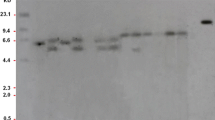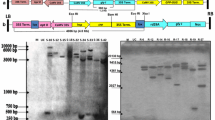Abstract
Glyphosate is a very effective post-emergent herbicide which is widely used by farmers for controlling almost all kinds of annual and perennial weeds. Over the last thirty years, various strategies have been used to develop glyphosate-tolerant crop plants using the tolerant EPSPS alone and/or in combination with other glyphosate detoxifying genes. In this series, the bacterial igrA (increased glyphosate resistance) gene has also been reported to exhibit glyphosate tolerance by degrading into non-toxic products, although its efficacy was not inspected thoroughly. Considering the fact, we investigated the efficiency of igrA for glyphosate tolerance by overexpressing it into three different cellular locations viz, phloem (Ph) cytoplasm (Cy) or chloroplast (Ch) independently in transgenic rice plants. The igrA transgenic -plants were able to survive at the highest 50 µM glyphosate concentration while the wt died shortly even at 20 µM, confirmed by seed germination assay. Further, the transgenic plants showed improved tolerance upon foliar spraying with 2 mL/L (4.2 mM) of glyphosate in comparison to wt. All the three differentially expressed (Ph, Cy and Ch) transgenic rice lines exhibited almost similar responses towards glyphosate application. This study highlights the modest detoxification efficiency of igrA transgene irrespective of its differential cellular localization. The potential application of directed evolution strategies may improve the higher catalytic detoxification activity of igrA protein further, and could be successfully implemented for future development of higher glyphosate tolerant crops.
Key message
This research work confirms the modest tolerance of bacterial gene igrA against glyphosate in the transgenic rice plants expressing it in various subcellular locations like phloem, cytoplasm and chloroplast.





Similar content being viewed by others
Data availability
The datasets generated during and/or analysed during the current study are available from the corresponding author on reasonable request.
Abbreviations
- igrA :
-
Increased glyphosate resistance A
- EPSPS:
-
5-Enolpyruvylshikimate-3-phosphate synthase
- wt :
-
Wild type
- Ph:
-
Phloem
- Cy:
-
Cytoplasm
- Ch:
-
Chloroplast
References
Achary VMM, Sheri V, Manna M, Panditi V, Borphukan B, Ram B, Agarwal A, Fartyal D, Teotia D, Masakapalli SK, Agrawal PK, Reddy MK (2020) Overexpression of improved EPSPS gene results in field level glyphosate tolerance and higher grain yield in rice. Plant Biotech J 18:2504–2519
Amrhein N, Deus B, Gehrke P, Steinrucken HC (1980) The Site of the Inhibition of the Shikimate Pathway by Glyphosate: II. Interference of glyphosate with chorismate formation in vivo and in vitro. Plant Physiol 66:830–834. https://doi.org/10.1104/pp.66.5.830
Barry GF and Kishore GM (1998) Glyphosate tolerant plants. Patent US 5776760.
Beffa R, Menne H, Köcher H (2019) Herbicide resistance action committee (HRAC): herbicide classification, resistance evolution, survey, and resistance mitigation activities. Modern Crop Protect Comp 1:5–32
Borggaard OK, Gimsing AL (2008) Fate of glyphosate in soil and the possibility of leaching to ground and surface waters: a review. 456:441–456. https://doi.org/10.1002/ps.1512.
Castle LA, Siehl DL, Gorton R, Patten PA, Chen YH, Bertain S, Cho HJ, Duck N, Wong J, Liu D, Lassner MW (2004) Discovery and directed evolution of a glyphosate tolerance gene. Science 304:1151–1154. https://doi.org/10.1126/science.1096770
Chandrasekhar K, Reddy GM, Singh J, Vani K, Vijayalakshmi M, Kaul T, Reddy MK (2014) Development of transgenic rice harbouring mutated rice 5-Enolpyruvylshikimate 3-Phosphate synthase (Os-mEPSPS) and Allium sativum leaf agglutinin (ASAL) genes conferring tolerance to herbicides and sap-sucking insects. Plant Mol Biol Rep 32:1146–1157. https://doi.org/10.1007/s11105-014-0715-3
Curtis MD, Grossniklaus U (2003) A gateway cloning vector set for high-throughput functional analysis of genes in planta. Plant Physiol 133:462–469. https://doi.org/10.1104/pp.103.027979
Delaney B, Zhang J, Carlson G, Schmidt J, Stagg B, Comstock B, Babb A, Finlay C, Cressman RF, Ladics G, Cogburn A, Siehl D, Bardina L, Sampson H, Han Y (2008) A gene-shuffled glyphosate acetyltransferase protein from bacillus licheniformis (GAT4601) shows no evidence of allergenicity or toxicity. Toxicol Sci 102:425–432. https://doi.org/10.1093/toxsci/kfm304
Dill GM, Cajacob CA, Padgette SR (2008) Glyphosate-resistant crops : adoption, use and future considerations. Pest Manag Sci 331:326–331. https://doi.org/10.1002/ps.1501
Ding W, Reddy KN, Zablotowicz RM, Bellaloui N, Bruns HA (2011) Physiological responses of glyphosate-resistant and glyphosate-sensitive soybean to aminomethylphosphonic acid, a metabolite of glyphosate. Chemosphere 83:593–598. https://doi.org/10.1016/j.chemosphere.2010.12.008.Duke
Duke SO (2011) Glyphosate degradation in glyphosate-resistant and-susceptible crops and weeds. J Agric Food Chem 59:5835–5841. https://doi.org/10.1021/jf102704x
Duke SO (2018) The history and current status of glyphosate. Pest Manag Sci 74:1027–1034. https://doi.org/10.1002/ps.4652
Duke SO, Powles SB (2009) Glyphosate-resistant crops and weeds: now and in the future. AgBioforum 12:346–357
Dun B, Wang X, Lu W, Chen M, Zhang W, Ping S et al (2014) Development of highly glyphosate-tolerant tobacco by coexpression of glyphosate acetyltransferase gat and EPSPS G2-aroA genes. Crop J 2:164–169. https://doi.org/10.1016/j.cj.2014.03.003
Endo M, Toki S (2013) Creation of herbicide-tolerant crops by gene targeting. J Pest Sci 38:49–59. https://doi.org/10.1584/jpestics.D12-073
Fartyal D, Agarwal A, James D, Borphukan B, Ram B, Sheri V, Yadav R, Manna M, Varakumar P, Achary VMM, Reddy MK (2018) Co-expression of P173S mutant rice EPSPS and igrA genes results in higher glyphosate tolerance in transgenic rice. Front Plant Sci 9:1–13. https://doi.org/10.3389/fpls.2018.00144
Fitzgibbon JE, Braymer HD (1990) Cloning of a gene from Pseudomonas sp. strain PG2982 conferring increased glyphosate resistance. Appl Environ Microbiol 56:3382–3388. https://doi.org/10.1128/aem.56.11.3382-3388.1990
Funke T, Han H, Healy-Fried ML, Fischer M, Schönbrunn E (2006) Molecular basis for the herbicide resistance of Roundup Ready crops. Proc Natl Acad Sci USA 103:13010–13015. https://doi.org/10.1073/pnas.0603638103
Guo B, Guo Y, Hong H, Jin L, Zhang L, Chang RZ, Lu W, Lin M, Qiu LJ (2015) Co-expression of G2-EPSPS and glyphosate acetyltransferase GAT genes conferring high tolerance to glyphosate in soybean. Front Plant Sci 6:1–11. https://doi.org/10.3389/fpls.2015.00847
Hadi F, Mousavi A, Salmanian AH, Noghabi KA, Khajeh K (2012) Glyphosate tolerance in transgenic canola by a modified glyphosate oxidoreductase (gox) gene. Prog Biol Sci 2:50–58
Han H, Zhu B, Fu X, You S, Wang B, Li Z, Zhao W, Peng R, Yao Q (2015) Overexpression of D-amino acid oxidase from Bradyrhizobium japonicum, enhances resistance to glyphosate in Arabidopsis thaliana. Plant Cell Rep 34:2043–2051. https://doi.org/10.1007/s00299-015-1850-5
Howe AR, Gasser CS, Brown SM, Padgette SR, Hart J, Parker GB et al (2002) Glyphosate as a selective agent for the production of fertile transgenic maize (Zea mays L.) plants. Mol Breed 10:153–164. https://doi.org/10.1023/A:1020396708088
Kraehmer H, Jabran K, Mennan H, Chauhan BS (2016) Global distribution of rice weeds–a review. Crop Protect 80:73–86
Liu Y, Cao G, Chen R, Zhang S, Ren Y, Lu W, Wang J, Wang G (2015) Transgenic tobacco simultaneously overexpressing glyphosate N -acetyltransferase and 5-enolpyruvylshikimate- 3-phosphate synthase are more resistant to glyphosate than those containing one gene. Transgenic Res 24:753–763. https://doi.org/10.1007/s11248-015-9874-8
Maeda H, Dudareva N (2012) The shikimate pathway and aromatic amino Acid biosynthesis in plants. Annu Rev Plant Biol 63:73–105. https://doi.org/10.1146/annurev-arplant-042811-105439
Manna M, Achary VMM, Islam T, Agrawal PK, Reddy MK (2016) The development of a phosphite-mediated fertilization and weed control system for rice. Sci Rep 6:24941. https://doi.org/10.1038/srep24941
Mehta S, Kumar A, Achary VMM, Ganesan P, Rathi N, Singh A, Sahu KP, Lal SK, Das TK, Reddy MK (2021) Antifungal activity of glyphosate against fungal blast disease on glyphosate-tolerant OsmEPSPS transgenic rice. Plant Sci 311:111009
Nicolia A, Ferradini N, Molla G, Biagetti E, Pollegioni L, Veronesi F, Rosellini D (2014) Expression of an evolved engineered variant of a bacterial glycine oxidase leads to glyphosate resistance in alfalfa. J Biotechnol 184:201–208. https://doi.org/10.1016/j.jbiotec.2014.05.020
Packer MS, Liu DR (2015) Methods for the directed evolution of proteins. Nat Rev Genet 16:379–394. https://doi.org/10.1038/nrg3927
Pollegioni L, Schonbrunn E, Siehl D (2011) Molecular basis of glyphosate resistance-different approaches through protein engineering. FEBS J 278:2753–2766. https://doi.org/10.1111/j.1742-4658.2011.08214.x
Powles SB, Yu Q (2010) Evolution in action: plants resistant to herbicides. Annu Rev Plant Biol 61:317–347. https://doi.org/10.1146/annurev-arplant-042809-112119
Reddy KN, Rimando AM, Duke SO (2004) Aminomethylphosphonic acid, a metabolite of glyphosate, causes injury in glyphosate-treated, glyphosate-resistant soybean. J Agric Food Chem 52:5139–5143. https://doi.org/10.1021/jf049605v
Siehl DL, Castle LA, Gorton R, Chen YH, Bertain S, Cho HJ, Keenan R, Liu D, Lassner MW (2005) Evolution of a microbial acetyltransferase for modification of glyphosate: a novel tolerance strategy. Pest Manag Sci 61:235–240. https://doi.org/10.1002/ps.1014
Székács A, Darvas B (2012) Forty Years with Glyphosate, Herbicides - Properties, Synthesis and Control of Weeds, Mohammed Naguib Abd El-Ghany Hasaneen. IntechOpen. https://doi.org/10.5772/32491
Tian YS, Xu J, Peng RH, Xiong AS, Xu H, Zhao W, Fu XY, Peng RH, Yao QH (2015) Improved glyphosate resistance of 5-enolpyruvylshikimate-3-phosphate synthase from Vitis vinifera in transgenic Arabidopsis and rice by DNA shuffling. Mol Breeding 35:148. https://doi.org/10.1007/s11032-015-0327-0
Vemanna RS, Vennapusa AR, Easwaran M, Chandrashekar BK, Rao H, Ghanti K, Sudhakar C, Mysore KS, Makarla U (2017) Aldo-keto reductase enzymes detoxify glyphosate and improve herbicide resistance in plants. Plant Biotechnol J 15:794–804. https://doi.org/10.1111/pbi.12632
Wen L, Zhong J, Cui Y, Duan Z, Zhou F, Li C, Ma W, Yin C, Chen H, Lin Y (2021) Coexpression of I. variabilis-EPSPS* and WBceGO-B3S1 genes contributes to high glyphosate tolerance and low glyphosate residues in transgenic rice. J Agric Food Chem 69(26):7388–7398. https://doi.org/10.1021/acs.jafc.1c00880
Zhan T, Zhang K, Chen Y, Lin Y, Wu G, Zhang L, Yao P, Shao Z, Liu Z (2013) Improving glyphosate oxidation activity of glycine oxidase from Bacillus cereus by directed evolution. PLoS ONE 8(11):e79175. https://doi.org/10.1371/journal.pone.0079175
Zhou H, Arrowsmith JW, Fromm ME, Hironaka CM, Taylor ML, Rodriguez D, Pajeau ME, Brown SM, Santino CG, Fry JE (1995) Glyphosate-tolerant CP4 and GOX genes as a selectable marker in wheat transformation. Plant Cell Rep 15:159–163. https://doi.org/10.1007/BF00193711
Zobiole LHS, Kremer RJ, Oliveira RS, Constantin J (2010) Glyphosate affects photosynthesis in first and second generation of glyphosate-resistant soybeans. Plant Soil 336:251–265. https://doi.org/10.1007/s11104-010-0474-3
Zobiole LHS, Kremer RJ, Oliveira RS, Constantin J (2012) Glyphosate effects on photosynthesis, nutrient accumulation, and nodulation in glyphosate-resistant soybean. J Plant Nutr Soil Sci 175:319–330. https://doi.org/10.1002/jpln.201000434
Acknowledgements
VMMA acknowledges SERB, India for providing NPDF research fellowship.
Funding
This research was partially supported by NASF-ICAR, India (F.No. NFBSFARA/BS-3006/2012-13) awarded to MKR.
Author information
Authors and Affiliations
Contributions
MKR and VMMA conceived the project. VP, VS, VMMA, DF, AA, SM, AKV, HP, SK and AR conducted the experiments and performed data analysis. VMMA and DF drafted the manuscript.
Corresponding author
Ethics declarations
Conflict of interest
The authors declare no conflict of interest.
Additional information
Communicated by Goetz Hensel.
Publisher's Note
Springer Nature remains neutral with regard to jurisdictional claims in published maps and institutional affiliations.
Supplementary Information
Below is the link to the electronic supplementary material.
Rights and permissions
About this article
Cite this article
Panditi, V., Fartyal, D., Sheri, V. et al. Functional characterization of differentially-expressed increased glyphosate resistance (igrA) gene in transgenic rice (Oryza sativa L.). Plant Cell Tiss Organ Cult 150, 439–449 (2022). https://doi.org/10.1007/s11240-022-02295-4
Received:
Accepted:
Published:
Issue Date:
DOI: https://doi.org/10.1007/s11240-022-02295-4




